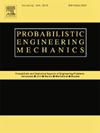Joint stationary response prediction of high-dimension strongly nonlinear systems with both uncertain parameters and stochastic excitation by solving FPK equation
IF 3
3区 工程技术
Q2 ENGINEERING, MECHANICAL
引用次数: 0
Abstract
Uncertainties in system parameters and dynamic loading are pervasive in engineering and significantly influence the dynamic response of systems. While random response analysis has been studied since the 1960s, predicting responses for high-dimension strongly nonlinear systems under both types of uncertainties remains a significant challenge. This study extends a decoupled Fokker–Planck–Kolmogorov (FPK) equation approach to predict the joint stationary response of high-dimension strongly nonlinear systems with uncertain parameters under additive and/or multiplicative white noise excitations. Leveraging the law of total probability and the subspace method, the decoupled FPK equation governing the unconditional joint probability density function (PDF) of the state variables of interest are derived. These decoupled equations can effectively handle both uncertainties while avoiding the complications of high dimensionality and large numbers of uncertain parameters. Subsequently, the neural network-based methods combined with an efficient hypersphere sampling strategy are used to deal with the decoupled FPK equation, yielding non-Gaussian joint PDFs. Three examples, including the Rayleigh system, the inclined nonlinear cable system, and a high-dimension nonlinear base-isolation frame system with the maximum number of uncertain parameters up to 25, are studied for illustration. Extensive Monte Carlo simulation data validate the accuracy and efficiency of the proposed scheme. The results demonstrate that the proposed approach successfully captures the complex-shaped joint PDF of the strongly nonlinear system, even for the challenging five dimension case. Notably, parameter uncertainties can lead to a reduction of up to 20% in the peak PDF of the responses and an increase in the tail PDF by several orders of magnitude compared to deterministic systems.
求解FPK方程预测具有不确定参数和随机激励的高维强非线性系统联合平稳响应
系统参数和动载荷的不确定性在工程中普遍存在,对系统的动态响应有重要影响。虽然随机响应分析自20世纪60年代以来一直在研究,但预测两种不确定性下高维强非线性系统的响应仍然是一个重大挑战。本文扩展了一种解耦Fokker-Planck-Kolmogorov (FPK)方程方法,用于预测具有不确定参数的高维强非线性系统在加性和/或乘性白噪声激励下的联合平稳响应。利用总概率定律和子空间方法,导出了控制感兴趣状态变量无条件联合概率密度函数(PDF)的解耦FPK方程。这种解耦方程既能有效地处理不确定性,又能避免高维数和大量不确定参数的复杂性。然后,利用神经网络方法结合高效的超球采样策略对解耦FPK方程进行处理,得到非高斯联合pdf。通过对瑞利系统、倾斜非线性索系统和最大不确定参数达25个的高维非线性基础隔震框架系统三个实例的研究进行了说明。大量的蒙特卡罗仿真数据验证了该方案的准确性和有效性。结果表明,该方法成功地捕获了强非线性系统的复杂形状关节PDF,即使在具有挑战性的五维情况下也是如此。值得注意的是,与确定性系统相比,参数不确定性可导致响应的峰值PDF减少高达20%,而尾部PDF增加几个数量级。
本文章由计算机程序翻译,如有差异,请以英文原文为准。
求助全文
约1分钟内获得全文
求助全文
来源期刊

Probabilistic Engineering Mechanics
工程技术-工程:机械
CiteScore
3.80
自引率
15.40%
发文量
98
审稿时长
13.5 months
期刊介绍:
This journal provides a forum for scholarly work dealing primarily with probabilistic and statistical approaches to contemporary solid/structural and fluid mechanics problems encountered in diverse technical disciplines such as aerospace, civil, marine, mechanical, and nuclear engineering. The journal aims to maintain a healthy balance between general solution techniques and problem-specific results, encouraging a fruitful exchange of ideas among disparate engineering specialities.
 求助内容:
求助内容: 应助结果提醒方式:
应助结果提醒方式:


